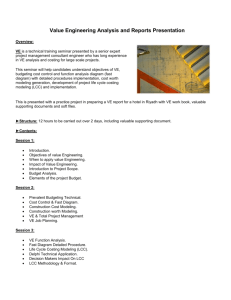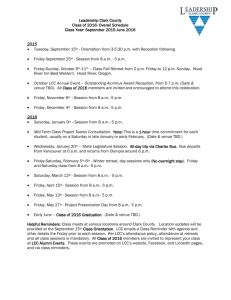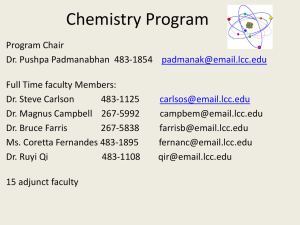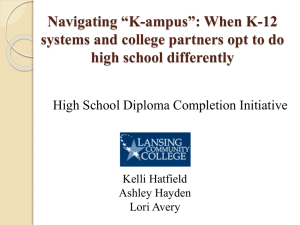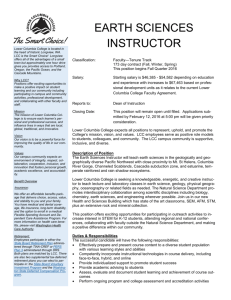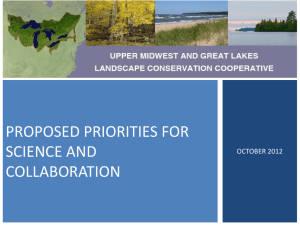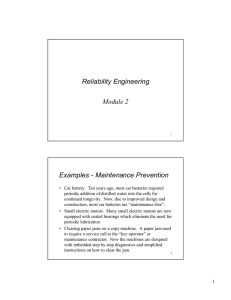Budgeting - Department of Mechanical and Automation Engineering
advertisement
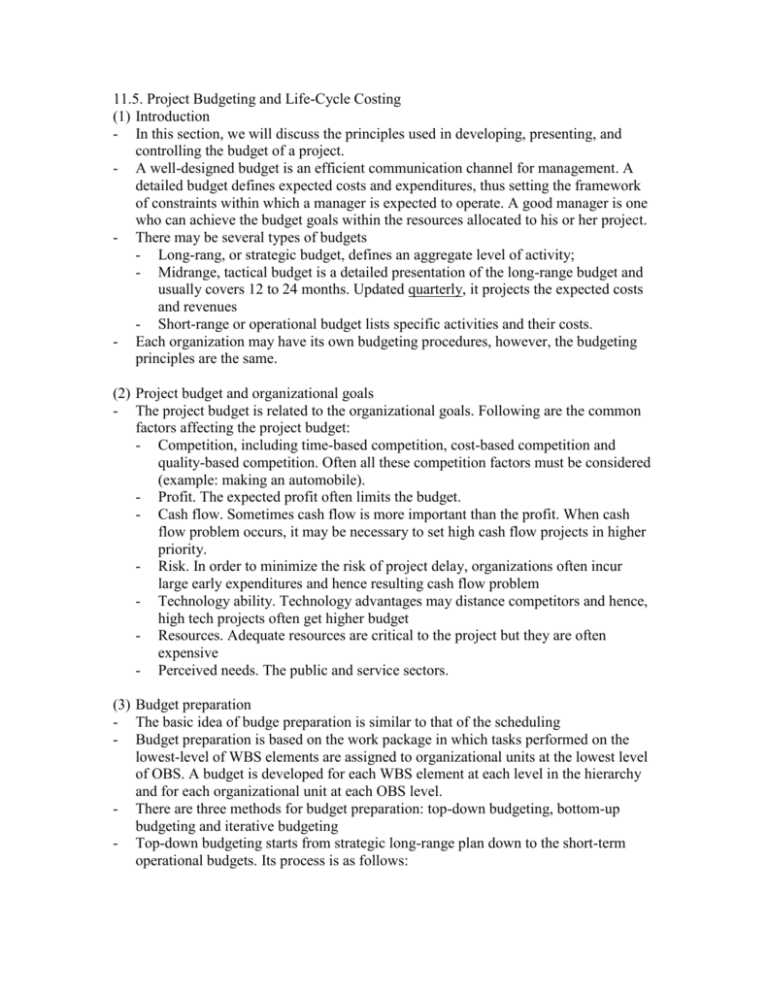
11.5. Project Budgeting and Life-Cycle Costing (1) Introduction - In this section, we will discuss the principles used in developing, presenting, and controlling the budget of a project. - A well-designed budget is an efficient communication channel for management. A detailed budget defines expected costs and expenditures, thus setting the framework of constraints within which a manager is expected to operate. A good manager is one who can achieve the budget goals within the resources allocated to his or her project. - There may be several types of budgets - Long-rang, or strategic budget, defines an aggregate level of activity; - Midrange, tactical budget is a detailed presentation of the long-range budget and usually covers 12 to 24 months. Updated quarterly, it projects the expected costs and revenues - Short-range or operational budget lists specific activities and their costs. - Each organization may have its own budgeting procedures, however, the budgeting principles are the same. (2) Project budget and organizational goals - The project budget is related to the organizational goals. Following are the common factors affecting the project budget: - Competition, including time-based competition, cost-based competition and quality-based competition. Often all these competition factors must be considered (example: making an automobile). - Profit. The expected profit often limits the budget. - Cash flow. Sometimes cash flow is more important than the profit. When cash flow problem occurs, it may be necessary to set high cash flow projects in higher priority. - Risk. In order to minimize the risk of project delay, organizations often incur large early expenditures and hence resulting cash flow problem - Technology ability. Technology advantages may distance competitors and hence, high tech projects often get higher budget - Resources. Adequate resources are critical to the project but they are often expensive - Perceived needs. The public and service sectors. (3) Budget preparation - The basic idea of budge preparation is similar to that of the scheduling - Budget preparation is based on the work package in which tasks performed on the lowest-level of WBS elements are assigned to organizational units at the lowest level of OBS. A budget is developed for each WBS element at each level in the hierarchy and for each organizational unit at each OBS level. - There are three methods for budget preparation: top-down budgeting, bottom-up budgeting and iterative budgeting - Top-down budgeting starts from strategic long-range plan down to the short-term operational budgets. Its process is as follows: Step 1 - 2 Department 3 Project Budget preparation Strategic budget based on organizational goal, constraints, and policies Tactical budget for each involved department Detailed budgets for each project, including the cost of labor, material, subcontracting, overhead, and etc. However, in this method it is difficult to design an “optimal” budget as the top management may not know the need of every details of the project. Also, the lowerlevel managers often try to get as much as they, which means cutting the budget of other units in the budget. Bottom-up budgeting starts from the top management and ends back to the top management. Its process is as follows: Step 1 2 3 4 - Organizational level Top management Organizational level Top management Project Department Top management Budget preparation Setting the goal (framework for budget) Detailed budget proposals including costs of labor, material, subcontracting, etc. Midrange budget for each project unit Adjustment and approval of the aggregate long plan budget resulting from the process The problem of this method is the reduced level of control from the top management as the lower-level managers may try to “maximize” their budget. Iterative budgeting combines the top-down method and the bottom-up method, especial the later. It usually produces better budgets. (4) Techniques for managing budget - After a budget is approved, the next step is budget management, or put it in simpler words, to spend the money. - We will assume that there is a room in total budget and schedule and budget management is to work along the nominal budget and the schedule. - There are several methods of budget management: slack management and crashing. - Slack management. - Non-critical activities that have free slack are usually the first candidates as the rescheduling may result in better cash flow. - As an example, let us consider the example we used in scheduling. Suppose the costs for each activity are as follows: Activity A B C duration (week) 5 3 8 cost ($1,000) 1.5 3.0 3.3 D E F G Total 7 7 4 5 4.2 5.7 6.1 7.2 31.0 Also, assume that the money spent in each activity is evenly distributed. Then, by summing the costs of all activities in each week, the following figure is obtained showing the cash flow of the early start and late start schedules: 2500 2000 1500 early start weekly cost late start weekly cost 1000 500 0 1 3 5 7 9 11 13 15 17 19 21 - - From the figure, it is seen that one can balance the cash flow by adjusting the starting activities at different time - The method for optimizing the cash flow is linear programming and it is beyond the scope of this class. Crashing. - Crashing is to add money to critical activities to accelerate their completion and hence, to accelerate the project completion. - To determine the affects of crashing, we can follow the same principle applied to scheduling and costing while thinking in a radical term. - Based on the crashing data, we can reschedule the project to reduce the project time when necessary. - Let us again consider the example above. Suppose the crashing results are as follows: Activity A B C D Norma duration 5 3 8 7 cost ($1,000) 1.5 3.0 3.3 4.2 Crashing duration 4 2 7 6 additional cost ($1000) 2.0 2.0 2.0 2.0 E F G 7 4 5 5.7 6.1 7.2 6 3 4 1.0 1.0 1.0 Then, the following figure shows the project cost as a function of its duration. 50 45 40 35 Direct cost ($1000) 30 25 Penalty ($1000) 20 total project cost ($1000) 15 10 5 0 -5 10 12 14 16 18 20 22 24 Suppose there is a penalty for the projecting being exceed 18 weeks, then, as shown in the figure, the best solution will crashing the project to about 19 weeks. - Usually, slack management and crashing can be solved by means of linear programming. You may refer to related monographs in this subject (5) Project execution - During the project’s execution phase, three processes occur simultaneously: - The short-range budget is translated into work and purchase - The tactical budget is translated into a short-range budget through rolling mechanism - The long-range budget is converted into the midrange budget. - The project execution can be viewed as a system: the input is the money and the output is the results. While this is generally true, it is important to note the following: - The budget links the schedule, resources and the value. It provides an action framework for the project. - The budget is a communication channel to inform organizational goals (6) The life-cycle costing - Life-cycle costing (LCC) has two meanings: - It is the total cost of ownership of a product, structure, or system over its useful life - - - - It is a general method of economic evaluation which takes into account all relevant costs of a building design, system, component, material, or practice over a given period of time adjusting for differences in the timing of those costs. In the introduction to project management, it has been mentioned that the life-cycle of a system or a product consists of five phases: - Conceptual design - Advanced development and detailed design - Production - Project termination and system operation and maintenance - System divestment LCC is the total cost of these phases. Examples - Buying a TV set (the purchasing price is only 62% of the total cost) - Buying an air conditioner (the purchasing price is 58% of the total cost) LCC analysis help us to evaluate the economic consequences of a decision - Example 1: quality components or else - Example 2: testing and evaluation - Example 3: logistics support (7) LCC models - The LCC models shall include all significant costs that are likely to arise over the system’s life cycle. - There may be different ways to classify the costs, such as - By the five life-cycle phases - By the direct costs (e.g., labor, material, subcontracting, …) and indirect costs (e.g., tool, supply, energy, coolant, quality control, …) - By the time period in which each cost component is realized - By work breakdown structure - Following is an example of LCC model by life-cycle phases. Conceptual design Time labor mat. 1 2 2 3 3 3 4 1 5 6 7 8 9 10 11 12 Detailed design labor mat. 3 4 5 5 3 1 1 1 1 Production labor mat. 10 12 15 10 7 3 4 6 5 3 Operation & maintenance labor mat. 3 4 5 5 1 2 3 3 Divestment labor mat. Total 2 3 3 4 5 19 22 25 19 16 8 8 13 14 15 16 17 Sum - 9 20 4 53 21 5 5 4 4 3 38 3 3 2 2 1 20 1 1 1 3 8 9 7 6 5 169 From the table, one can view various break-downs, such as material cost vs. labor cost, the cost in different phases, the costs in different time (note that time is usually divided in quarters). The LCC model help us the see the cost of the entire life cycle of a product or a system. (8) Developing a LCC model - Before developing a LCC model, we shall first identify the purpose: - Is the LCC model for strategic or long-term budgeting? - Is it for technical decision? - Is it for data analysis and processing? - Is it for logistic support analysis - - Different purpose may require different amount of details and focus. Developing a LCC model takes several steps. - Step 1: classification. The major activities are classified into different categories. The example above is a good example - Step 2: determine a cost breakdown structure (CBS). This is similar to WBS - Step 3: cost estimation. Depending on the purpose, the cost estimate may range from “order of magnitude” (40%), “budget” (20%), to “definitive (10%). Various estimation procedures are used in industry, all of which are based on the assumption that past experience is a valid predictor of future performance. An example: equipment cost model: m Q C C r c Qr where, C = Cost for a new design size Q. Cr = Cost for existing reference design Qc = Design size – new design Qr = Design size – existing reference design m = correlation parameter, 0 < m < 1 - Note that the parameters Cr, Qc, Qr and m can be obtained based on existed model data. Example: How to determine the cost of a used robot (9) Using the LCC model - LCC model can be used for various analysis and decision making - Design evaluation - Evaluation of engineering change requested Sensitivity analysis and risk assessment Logistic support analysis Critical expenditures analysis Budget and cash flow analysis
